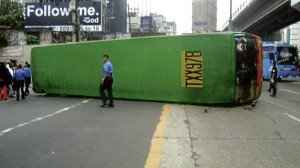
The Nova Auto Transport bus that went wayward lies across the southbound lane on Edsa Wednesday morning, snarling the rush-hour traffic. MMDA ROAD EMERGENCY GROUP FILE PHOTO
MANILA, Philippines–Don’t drink and drive. This time the authorities mean it.
This admonition against drunk driving now comes with tough penalties—a fine of as much as P500,000, as well as a corresponding jail term.
President Aquino signed on May 27 Republic Act No. 10586, otherwise known as the Act Penalizing Persons Driving Under the Influence of Alcohol, Dangerous Drugs and Other Similar Substances.
The anti-drunk and -drugged driving law, which was designed to ensure road safety, takes effect 15 days after its publication.
Deputy presidential spokesperson Abigail Valte, who announced the signing of the law in a Palace briefing, admitted that it could be open to abuse, especially by traffic enforcers who would demand bribes from motorists.
However, she said grievance mechanisms were in place.
“We encourage the reporting of law enforcement officers who may want to take advantage of this law,” Valte said of the safety nets for motorists against “kotong (extortion) cops.”
The law mandates the Land Transportation Office, Philippine National Police, Metropolitan Manila Development Authority and deputized local traffic enforcers to conduct sobriety tests on drivers suspected of drunk driving.
Motorists may be pulled over on suspicion of driving under the influence (DUI) by a “law enforcement officer who has probable cause to believe that a person is driving under the influence of alcohol, dangerous drugs and/or similar substances by apparent indications and manifestations.”
According to the law, the telltale signs of a DUI are “overspeeding, weaving, lane straddling, sudden stops, swerving, poor coordination, evident smell of alcohol in a person’s breath or signs of use of dangerous drugs and other similar substances.”
Traffic enforcers are required to use a breath analyzer (breathalyzer), a gadget to determine the blood alcohol concentration level of a person through testing of his or her breath.
“Your law enforcement agencies are now empowered under this law to conduct field sobriety, chemical and confirmatory tests,” said Valte.
“If the law enforcement officer feels that there is any indication that the driver is under the influence of the relevant substances, under this law he may pull you over and ask you to undertake a sobriety test,” she said.
Failing the sobriety test, the person under question may be subjected to a breathalyzer.
The law, however, does not specify the “level of intoxication” needed to fall within the definition of a DUI.
Instead of setting a threshold level, the law gives the determination to the Department of Health, National Police Commission and Department of Transportation and Communications.
In the United States, the current blood alcohol level limit is pegged at 0.08 percent.
For drivers suspected of driving under the influence of illegal drugs, law enforcement officers may bring the driver to the nearest police station for drug testing.
There shall be compulsory alcohol and/or chemical testing, including a drug screening test, of drivers involved in motor accidents, as mandated by Republic Act No. 9165 (Comprehensive Dangerous Drugs Act of 2002).
Aside from the mandatory testing of drivers involved in accidents, the law calls for “direct liability of operators and/or owner of the offending vehicle” of public utility vehicles, delivery vans, cargo trucks, container trucks, school and company buses, hotel transports, cars or vans for rent and taxi cabs.
The vehicle owner and offending driver will be principally held liable for civil damages.
Penalties range from three-month imprisonment and fines of P20,000 to P80,000 if the violation did not result in physical injuries.
The fines get heavier if the violation results in physical injury.
“The fine goes up to P100,000 to P200,000 and the penalty for imprisonment also goes up. If the violation involves homicide, the fine goes up to P300,000 to P500,000, as well as the penalty for imprisonment,” said Valte.
The law also funds the acquisition of equipment (breath analyzers and drug-testing kits) and nationwide training seminars for deputized law enforcers, to be taken from the Special Road Safety Fund (derived from the motor vehicle user’s charge) and the General Appropriations Act.
Section 4 mandates driver’s education to be part of procedures for getting or renewing one’s driver’s license.
“Driver’s education should now include the course on the information relative to safe driving, including the consequences of driving or operating a motor vehicle under the influence of the aforementioned substances,” Valte said.
She said the Philippine Information Agency, Land Transportation Office and local government units involved have been mandated to conduct a nationwide information campaign on the effects and parameters of this particular law.
Valte said the law had a “provision for training” of traffic personnel for conducting sobriety tests.